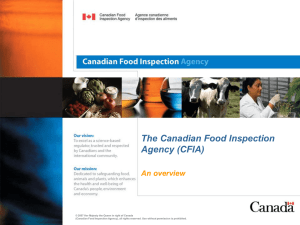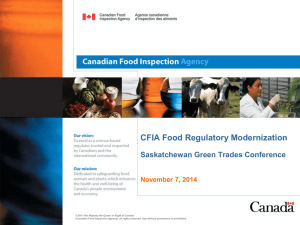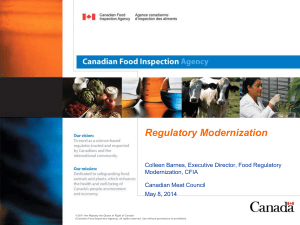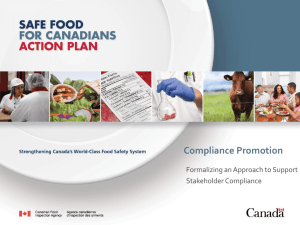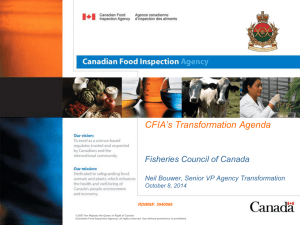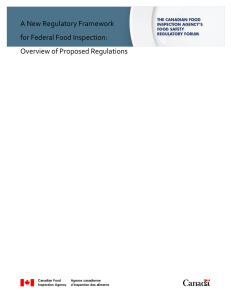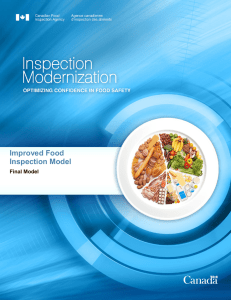Presentation - the Canadian Health Food Association
advertisement
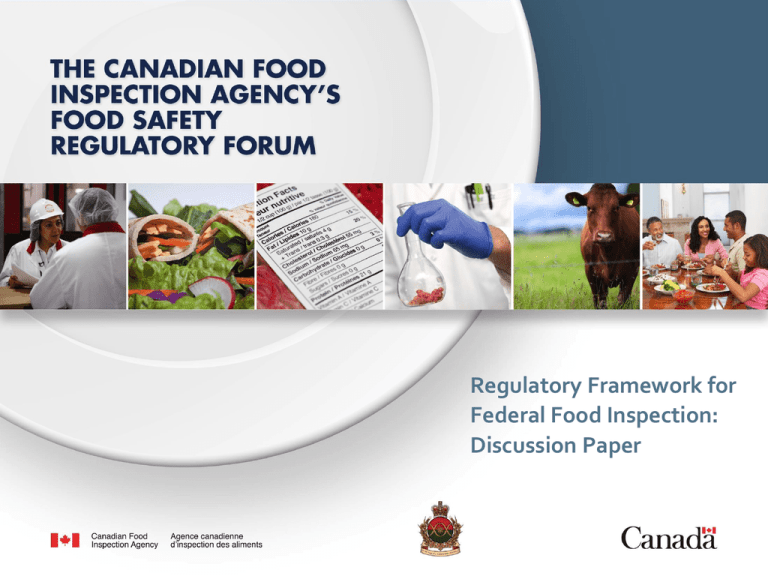
Regulatory Framework for Federal Food Inspection: Discussion Paper Purpose • To provide an overview of elements of a new regulatory framework for federal food Inspection • To answer any questions that might assist participants to further engage with others over the course of the consultation period • To gather initial feedback and reactions. 2 Modern Legislation Passed by Parliament… • Safe Food for Canadians Act (SFCA) received Royal Assent in 2012; enables strengthened and modernized federal food safety inspection system; new regulations required to bring SFCA into force • Act will replace three CFIA inspection statutes – Meat Inspection Act, Fish Inspection Act, and Canada Agricultural Products Act – and food provisions of Consumer Packaging and Labelling Act • Food and Drugs Act (FDA) continues to apply to all food sold in Canada – Health Canada undertaking separate but coordinated modernization of food regulations under FDA • Discussion document sets out proposed elements of broad framework for new federal food inspection regulations, including specific proposals to stimulate debate, generate ideas, and provide starting point for discussions • Marks first step in regulatory process and offers an opportunity for industry and Canadians to participate in development of new federal food inspection regulatory framework • Consultation will be open until November 30, 2013 – stakeholders asked to review framework, provide comments, respond to questions • CFIA available to explain proposals/listen to feedback 3 Overview of Proposed Approach • New food regulations will draw together federal food inspection regulations in Canada into one overarching system that: – Is focused on prevention and greater industry accountability – Is capable of rapidly mitigating risks to food safety in a way that reduces impacts on consumers – Enables a risk-based approach to inspection of food commodities and establishments that pose greatest risk – Helps identify and prevent emerging food safety issues – Puts the emphasis on expected safety outcomes to allow all enterprises, especially small and medium enterprises to achieve compliance in way that can be tailored to their operational needs, and – Enables the CFIA to apply consistent regulatory requirements and inspection approaches 4 CFIA Food Regulations – Today •Thirteen federal food inspection regulations will be replaced: – Dairy Products Regulations – Egg Regulations – Processed Egg Regulations – Processed Products Regulations – Fresh Fruit & Vegetable Regulations – Honey Regulations – Maple Products Regulations – Licensing and Arbitration Regulations – Organic Products Regulations – Livestock & Poultry Carcass Grading Regulations – Meat Inspection Regulations – Fish Inspection Regulations – food related provisions of Consumer Packaging and Labelling Regulations 5 Proposed Content - Tomorrow • Replace with single set of regulations that includes: – Horizontal provisions applying to all food imported and prepared for trade inter-provincially (e.g licensing, preventive controls, traceability, recordkeeping) – Commodity–specific food safety requirements (e.g. fresh fruit and vegetables) – Commodity-specific trade requirements and consumer protection provisions (e.g. standards of identity, grades, container sizes, inspection marks, labelling) – Complementary regulations regarding disclosure of information and administrative monetary penalties • The new regulations would not apply to food traded solely within a province or territory 6 Horizontal Requirements: Licensing • Licensing allows CFIA to authorize activity and attach specific conditions. It also allows CFIA to identify who is preparing or importing food in Canada, where food businesses are located and what activities they are conducting. • The proposed regulations would: – broaden licensing requirements so everyone who imports or prepares food for inter-provincial trade would be required to have a licence • Will apply to many who were not covered by CFIA regulations in past – Allow regulated parties to apply for multiple licenses – for example for each physical location, for a number of locations or by activity – The license would be valid for two years. • A fee would apply for the licenses. 7 Horizontal Requirements: Preventive Control Plans (PCPs) • Preventive control plan (PCP) sets out in writing how food safety and other regulatory requirements (e.g. related to labelling, product composition, allergens) will be achieved. • PCPs recognized internationally as best way to demonstrate that food safety risks and hazards are controlled because it focuses on prevention and systems-based examination of potential hazards. • The proposed regulations would entrench management responsibility by requiring licence holders to have a PCP that demonstrates how they achieve regulatory requirements (safety and other requirements) and describe how management controls their operations, including how they monitor, verify and correct deviations, and respond to unforeseen food safety situations. 8 Horizontal Requirements: Outcome-based Requirements • Proposal to move from prescriptive commodityspecific rules that cover some food commodities, to system of expected outcomes and regulatory requirements for all food traded across borders. • Approach provides flexibility to introduce new technologies and processes that could enhance safety and/or reduce costs. • Depending on nature of operation, PCPs would include some or all of following elements: – processes and products – equipment design and maintenance – sanitation and pest control – employee hygiene and training – receiving, transportation and storage – physical structure and maintenance of the establishment – recall and complaints Examples : Floors, Walls, Ceilings • Floors, walls, and ceilings shall be constructed of material that is durable, impervious to moisture, smooth, cleanable, and suitable for the production conditions in the area. • Floors shall have drainage that prevents standing or pooled water Water/Ice/Steam • The quality and safety of water, ice and steam in direct contact with food or food contact surfaces is controlled to prevent contamination. • Water shall be potable or clean and shall be suitable for the process being undertaken • Water, ice and steam shall be sampled, tested and analyzed to confirm their safety for the intended purpose. 9 Horizontal Requirements: Suspension and Cancellation of License • Proposed regulations will include ability to suspend and cancel licences, as well as criteria for application of these enforcement tools. • Minister may suspend a licence if: – licence holder has not complied with conditions of licence or any provision of Act or regulations – licence holder has unpaid fees – reasonable to believe that public health may be endangered if licence holder continues to import, export or prepare a food commodity for export or inter-provincial trade. • Minister may cancel a licence if: – The licence was issued on the basis of false or misleading information, or false or falsified documents submitted in or with the application – reason for suspension cannot be resolved within 90 days following day on which licence was suspended - a longer time period may be granted upon request of licence holder; – licence holder continued to import, export, or prepare a food commodity for export or inter-provincial trade while their licence is under suspension 10 Horizontal Requirements: Traceability and Record Keeping • Rapid identification of origin and movement of a food commodity is essential for protecting consumers during a food recall • Proposed regulations would apply Codex standard of maintaining records on inputs and distribution, “One step forward, one step backwards”, to every stage of food supply chain, from primary producer to retailer • Regulations would require that operators: – collect and maintain traceability information in an accessible, useable format, in English or in French. – provide records to CFIA on request , un-encrypted and within 24 hours in a format which can be imported and manipulated by standard commercial software • Operator who believe that food is not in compliance with food safety requirements would have to : – immediately initiate procedures to withdraw the food from the market – inform the CFIA – inform consumers if it could have reached them and recall if necessary • Retailers, restaurants and catering companies will not be required to collect information about consumer purchases. • All records would need to be maintained and accessible at an address in Canada for a period of not less than three years. 11 Horizontal Requirements: Review and Redress Mechanism • On April 1, 2012, the CFIA created a Complaints and Appeals Office (CAO) to provide stakeholders with a "single window" approach and clearly defined process to submit complaints beyond frontline related to service delivery, administrative errors, and regulatory decisions. • With the passage of Safe Food for Canadians Act, role of CAO is expected to become a formal regulatory function, with authority to make new decisions. • New regulations will be made that will define the parameters of the decisions that are reviewable and a process for review, including: – Who can make a request for review of a decision – The manner in which a review officer must conduct the review – The manner in which an individual may make an application for review – The time in which an application must be made (likely 2 years) – Which decisions are ‘reviewable”. Areas currently being considered under the SFCA are: • suspension or cancel a registration or a licence • restriction of movement of an item • start or stop an activity or prohibiting or limiting access • Seizure and detention • Removal or destruction of unlawful imports 12 Commodity Specific Safety Requirements: Fresh Fruit and Vegetables • Fresh fruits and vegetables are sold raw and often not cooked prior to human consumption - many sources of contamination of produce in pre-harvest production and post-harvest processing. • In recent years, majority of global outbreaks have been associated with fresh fruit and vegetables. – Listeria, 2011 (USA) -- fresh whole cantaloupes - 23 deaths, 116 illnesses – E.coli, 2011 (Germany & France) - Egyptian fenugreek seeds used to produce sprouts --42+ deaths and almost 4000 illnesses • Food safety outbreak originating from a single farm could have devastating economic consequences to entire sector and diminish consumer confidence in fresh fruits and vegetables. • Proposed regulations propose to: – establish produce safety outcomes/requirements for fresh fruit and vegetables . – extend PCP requirements to farms who ship product directly to market in another province or to another country. • New requirements are consistent with Good Agricultural Practices and CanadaGAP, which has been CFIA recognized and internationally benchmarked. 13 Commodity Specific Trade and Consumer Protection Provisions General • In certain cases, commodity-specific requirements will be maintained – for example grades, standards of identity, container sizes, country of origin and labelling requirements • Food Labelling Modernization may ultimately re-engineer these areas (e.g. country of origin). In interim, current regulatory process is an opportunity to clean up our regulatory framework recognizing policy intent and importance to industry and consumers in mind: – Where policy intent is clear and should apply to all food commodities, CFIA will replace the multiplicity of unique commodity-based requirements with a single horizontal requirement (eg. font size will be reframed as a legibility requirement; various language requirements will be replaced with single requirement for bilingual labelling) – Consolidate and group provisions of similar purpose for a general clean-up – Where provision is important, no substantive changes will be made. • – CFIA reviewing whether some groupings would be appropriate for Incorporation by Reference (IBR) Some elements could be considered for deregulation in order to reduce unnecessary regulatory burden 14 Commodity Specific Trade and Consumer Protection Provisions – FDA-SFCA overlap • • • • • • Labelling and standards of identity provisions exist in Food and Drug Regulations (FDR) administered and in regulations under CAPA, MIA, FIA and CPLA. Duplication and inconsistencies exist between these provisions. Industry has often criticized current sets of regulations for being confusing and impeding innovation. Labelling and Standards of Identity requirements in FDR will not change in this round of amendments. While Food Labelling Modernization Initiative may ultimately re-engineer these provisions, drafting of new regulations under the SFCA represents an opportunity to improve uniformity Proposed labelling and standards of identity sections under new CFIA food regulations will include: - reference to the FDR where appropriate; - requirements currently under CAPA, FIA, MIA, CPLA not already covered in the FDR; and - commodity specific requirements When the duplication between the current sets of regulations cannot simply be eliminated, a provision by provision analysis will be done to determine which provision will be maintained taking into consideration industry preference and consumer protection. 15 Commodity Specific Trade Requirements and Consumer Protection – Other Proposed Elements • Organics Products Regulations: Organics regulations do not currently cover aquaculture because they were under CAPA. An Aquaculture Organic Standard is now published and SFCA regulations represent an opportunity to include aquaculture, as well as to address some other non-substantive issues, such as unclear wording in some places. • Licensing and Arbitration Regulations (LAR): Replace regulations and “dual licensing” with a requirement for fruit and vegetable dealers to be members of a non-government entity to facilitate orderly trade and better align with system in United States 16 Complementary Regulations • Specific situations listed where Agency would consider disclosure of personal and confidential business information without consent – e.g. food safety investigations, notices of violations • Proposing to explore the application of administrative monetary penalties to food-related violations. 17 Coming into Force and Next Steps • Consultations on “A New Regulatory Framework for Federal Food Inspection” will continue until November 30, 2013 • Food Forum marks the launch of consultation • Formal Notice of Intent of new federal food inspection regulations in Spring 2014 , including – Draft content of food inspection regulations – Supported by first draft suite of guidance documents for industry • Target for new Food Inspection Regulations to Come into Force: January 2015 18 Questions for Consideration 1. How could CFIA assist industry, particularly small or previously nonregistered companies, in meeting regulatory outcomes? 2. Are there any other elements in the proposed regulations that you: Strongly support? Why? Raise significant concerns? Why? 3. Are there elements in the proposed regulations that can be assumed by industry? If yes, please identify and provide rationale. 19 Feedback 20 • By email: CFIA-Modernisation-ACIA@inspection.gc.ca • By mail: Strategic Partnerships Division 1400 Merivale Road, Tower 1 Floor 6, suite 218 Ottawa, ON K1A 0Y9 Canada Attn: regulatory framework • By fax: 613-773-5606 20
